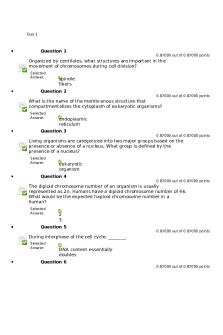PCB3063 Exam2Problem Set 1 Answer Key PDF

| Title | PCB3063 Exam2Problem Set 1 Answer Key |
|---|---|
| Course | General Genetics |
| Institution | University of South Florida |
| Pages | 2 |
| File Size | 94.7 KB |
| File Type | |
| Total Downloads | 45 |
| Total Views | 121 |
Summary
Practice Quiz - Mendelian Genetics...
Description
PCB 3063: Mendalian Genetics Problem Set – Answer Key 1. How many different types of gametes can be formed by individuals of the following genotypes, and what are the gametes in each case? Answers: The general formula for determining the number of kinds of gametes produced by an organism is 2n where n = number of heterozygous gene pairs
a. AaBb
4: AB, Ab, aB, ab
d. AaBBcc
2: ABc, aBc
b. AaBB
2: AB, aB
e. AaBbcc
4: ABc, Abc, aBc, abc
c. AaBbCc
8: ABC, ABc, AbC, Abc, aBC,
f. AaBbCcDdEe
25 = 32
aBc, abC, abc
2. Albinism is a recessive human trait. If a normal couple produces an albino child, what is the probability that their next child will be albino? ANSWER: normal couple with albino child—both parents must be heterozygotes for the trait so Aa X Aa; genotypes in offspring: ¼ AA, ½ Aa, ¼ aa. ¼ chance.
3. Phenylketonuria (PKU) is a human hereditary disease that prevents the body from processing the chemical phenylalanine, which is contained in the protein we eat. PKU is manifested in early infancy and, if untreated, generally leads to mental retardation. PKU is caused by a recessive allele with simple Mendelian inheritance. A couple intends to have children but consults with a genetic counselor because the man has a sister with PKU and the woman has a brother with PKU. There are no other known cases in their families. They ask the genetic counselor to determine the probability that their first child will have PKU. What is the probability? ANSWER: Parents are normal – their genotypes can be either be PP or Pp. -only way to have a child with PKU – both parents must be heterozygous. Referring back to the original Punnet square we see that the progeny can be ¼ pp, ½ Pp and ¼ PP. So, if the parent is phenotypically normal there is a 2/3 chance that the genotype is heterozygous. The probability of both parents being heterozygous is 2/3 X 2/3 = 4/9. If they are both heterozygotes, there is a ¼ chance that the child will have PKU. So the probability is 4/9 X ¼ = 4/36 = 1/9.
4. In seed color, gray seed color is dominant to white seed color. In the following experiments, parents with known phenotypes but unknown genotypes produced the following progeny: PARENTS
PROGENY GRAY
a. b. c. d. e.
gray X white gray X gray white X white gray X white gray X gray
WHITE
82 118 0 74 90
78 39 50 0 0
1
Using G for gray and g for white, deduce the most probable genotype for each parent. ANSWERS: A. Gg X gg B. Gg X Gg C. gg X gg D. GG X gg E. GG X G_
5. In garden peas, tall stem (T) is dominant over short stem (t), green pods (G) are dominant over yellow pods (g), and smooth seeds (S) are dominant over wrinkled seeds (s). Suppose a homozygous short, green, wrinkled pea plant is crossed with a homozygous tall, yellow, smooth one. ttGGss X TTggSS
1. What will be the appearance of the F1 generation? F1: tall, green smooth
2. What will be the genotype(s) of the F1 generation? TtGgSs
3. If the F1’s are interbred, what will be the appearance and ratios seen in the F2? 27/64: T_G_S_ tall, green, smooth 9/64: T_G_ss tall, green, wrinkled 9/64: T_ggS_ tall, yellow, smooth 3/64: T_ggss tall yellow, wrinkled 9/64: ttG_S_ short, green, smooth 3/64: ttG_ss short, green, wrinkled 3/64: ttggS_ short, yellow, smooth 1/64: ttggss short, yellow, wrinkled
4. What will be the possible genotypes of the F2 generation? Too many to type! Please just try some out to make sure you have the basic idea.
2...
Similar Free PDFs

Problem Set 2 Answer Key New 2
- 7 Pages

Lab Problem Set #2 answer key
- 3 Pages

Quiz 1 Answer Key
- 5 Pages

Quiz 1 Answer Key
- 3 Pages

Bios230 Problem Set 1 key
- 5 Pages

JUN2020 ( Question) - SET 1 Answer
- 13 Pages

PCB3063 Exam 1 Study Guide
- 9 Pages

HW 1 Answer Key - asdf
- 5 Pages

Chapter 1 Review Answer Key
- 3 Pages
Popular Institutions
- Tinajero National High School - Annex
- Politeknik Caltex Riau
- Yokohama City University
- SGT University
- University of Al-Qadisiyah
- Divine Word College of Vigan
- Techniek College Rotterdam
- Universidade de Santiago
- Universiti Teknologi MARA Cawangan Johor Kampus Pasir Gudang
- Poltekkes Kemenkes Yogyakarta
- Baguio City National High School
- Colegio san marcos
- preparatoria uno
- Centro de Bachillerato Tecnológico Industrial y de Servicios No. 107
- Dalian Maritime University
- Quang Trung Secondary School
- Colegio Tecnológico en Informática
- Corporación Regional de Educación Superior
- Grupo CEDVA
- Dar Al Uloom University
- Centro de Estudios Preuniversitarios de la Universidad Nacional de Ingeniería
- 上智大学
- Aakash International School, Nuna Majara
- San Felipe Neri Catholic School
- Kang Chiao International School - New Taipei City
- Misamis Occidental National High School
- Institución Educativa Escuela Normal Juan Ladrilleros
- Kolehiyo ng Pantukan
- Batanes State College
- Instituto Continental
- Sekolah Menengah Kejuruan Kesehatan Kaltara (Tarakan)
- Colegio de La Inmaculada Concepcion - Cebu






